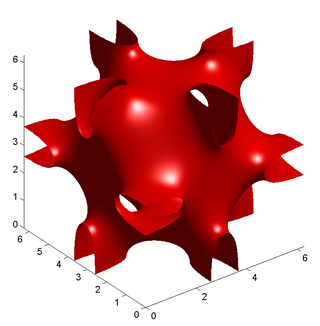Top Qs
Timeline
Chat
Perspective
Neovius surface
From Wikipedia, the free encyclopedia
Remove ads
In differential geometry, the Neovius surface is a triply periodic minimal surface originally discovered by Finnish mathematician Edvard Rudolf Neovius (the uncle of Rolf Nevanlinna).[1][2]

The surface has genus 9, dividing space into two infinite non-equivalent labyrinths. Like many other triply periodic minimal surfaces it has been studied in relation to the microstructure of block copolymers, surfactant-water mixtures,[3] and crystallography of soft materials.[4]
It can be approximated with the level set surface[5]
In Schoen's categorisation it is called the C(P) surface, since it is the "complement" of the Schwarz P surface. It can be extended with further handles, converging towards the expanded regular octahedron (in Schoen's categorisation)[6][7]
Remove ads
References
Wikiwand - on
Seamless Wikipedia browsing. On steroids.
Remove ads

